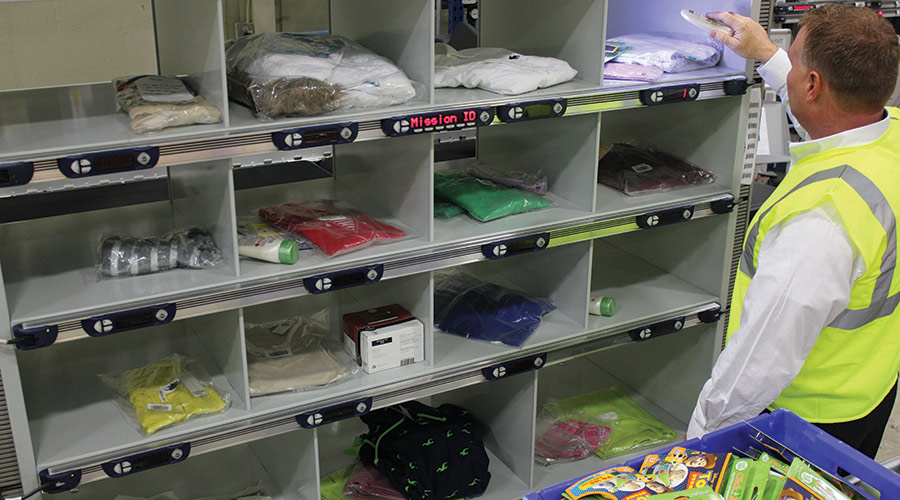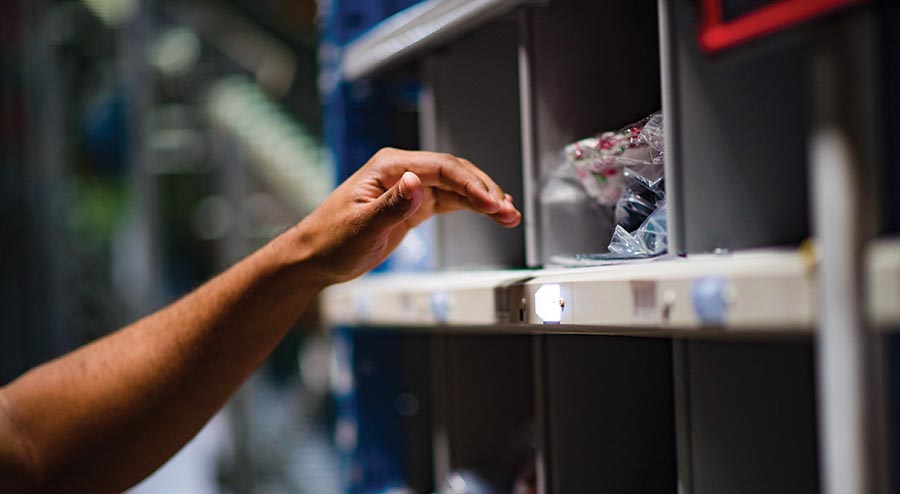Fulfillment at the speed of light
Powered by dynamic, real-time software, light-directed picking and putting technologies have entered a new phase in their evolution.

In the beginning, light-directed picking technology behaved like Christmas tree lights; if one went down, so did the rest on that loop. Eager for a more reliable approach, the industry then adopted bus-based lights, where each light can be individually controlled, relocated or replaced. These still make up the majority of light installations, even as a fully wireless third-generation gains some ground. Emerging on the horizon are an assortment of hybrids, including early versions of augmented reality (AR) picking technologies that could make lights’ hardware infrastructure obsolete.
For now, the hardware is not where the action is. Unsurprisingly, software advances are at the center of reshaping light-directed solutions’ functionality. Whether for picking or putting, light technologies have entered a new phase in their evolution as they support e-commerce and omni-channel fulfillment.
Put in its place
For starters, lights are now more commonly associated with putting than picking. The original light-directed technology was designed for pick-to-light order assembly methods, says Ken Ruehrdanz, manager of the distribution systems market for Dematic. It was followed by the put-to-light method of order assembly used for retail store replenishment applications.
“Put-to-light is used more often due to the wide market embrace of the goods-to-person methodology,” Ruehrdanz says.
Instead of moving through the warehouse to build an order, operators are delivered a single product to allocate (put) to the orders that require that SKU. Ruehrdanz says this approach is popular whether orders are bound for the retail store, industrial user or consumer.
“Put systems have many benefits,” he adds. “The major benefit of the put configuration is the elimination of the dedicated pick face. This means no need for slotting and re-slotting the warehouse.”
Jeff Holmes, vice president of design engineering for Wynright Daifuku, has also witnessed lights’ transition from pick to put.

To support e-commerce and omni-channel fulfillment, the same put wall can support order assembly as well as returns.
“I have experience with very large pick modules with thousands of locations all lit up,” he says. “We used to sell thousands of lights, several big projects a year, but haven’t seen many recently. Maybe we see one large scale pick-to-light project a year.”
Holmes cites the rise of voice-directed picking and other technologies with a low cost of entry and no physical infrastructure, and which in most scenarios get similar levels of productivity and error reduction. The most common light application now is some sort of goods-to-person scenario with a put wall, he says. The system might be fed by shuttles, mobile robots or even batch picking to a unit sorter and then to the put wall.
Holmes offers the interesting example of light-directed returns and receiving, where a book distributor uses put walls for order processing on the first shift, then uses them to process small mixed-SKU cases of returns. First, they scan a book and sort by publisher, then there’s a secondary put-to-light area to sort individual books.
“A similar concept could be used for any returns, maybe breaking down returns at the first step by category, then by SKU or zone,” Holmes says. “A multi-step, put-to-light process sounds like extra touches, but it can be a big benefit for returns, which are a headache for e-commerce.”
Anshul Singh, director of supply chain consulting at Bastian Solutions, says goods-to-person and robotic solutions are eating a significant portion of the pick-to-light market, which nonetheless remains “the most productive and fastest picking system in the industry,” he says. Sure, robots can match these rates, he adds, but they are limited by SKU profiles and replenishment rates.
“Goods-to-person are popular because of e-commerce, where you’re trying to carry more and more inventory,” Singh says. “The biggest risk in e-commerce is consumers switching very easily to another company if they can’t find a product. So, companies want to carry more and more SKUs.”
Twenty years ago, light-directed pick systems might serve one or two thousand SKUs, and 5,000 was considered a high SKU count. It might still be possible to use pick-to-light for a certain segment of SKUs and RF scanning for the rest, but with e-commerce, there’s no longer any guarantee fast movers will stay fast movers.
“Now, things change from product to product. Consumer choice changes, but the main reason is promotions, so it’s not steady or static,” Singh says. “SKUs change, which challenges pick-to-light, but goods-to-person can easily absorb those fluctuations.”
If you have a small SKU count with fast movers, it will always be a good fit for pick-to-light, Singh says—unless products are suitable for dispensers, which is the only faster technology.
“The only exception is vision-based picking. If it’s successful, it will definitely replace pick-to-light 100%,” Singh says. “But the hardware is not ready and operators are not ready to wear something on their head for eight hours without some dizziness and discomfort.”
Lights, software, picking
Dave Simpson, executive director of logistics solutions for SSI Schaefer Systems International, says balancing the work demand and the size of the zone can produce significant efficiencies.

Using bi-directional communication with the picker, lights can enable dynamic zone re-balancing, freeing managers from scrambling to allocate labor.
“That’s what you’re constantly trying to solve, but most people just tolerate the ebb and flow,” Simpson says. “In any application where a person sticks to a set zone, you will see half of them frantic and half kind of chilling, with the net effect of less productivity.”
One of the benefits of the latest software is the ability to dynamically re-size picker zones based on the actual work volume in each zone. Using real-time insights from processes upstream and downstream, software can rezone to ensure no worker is over- or under-burdened and prevent congestion in picking and packing. Holmes says predictive logic can also look ahead before releasing work to ensure no zones will be overwhelmed.
Distributor maximizes labor efficiency with lights and intelligent software
Mary Kay is one of the largest direct-selling companies in the world. After implementing supply chain software and a new light-directed picking system (Bastian Solutions), the company boosted hourly picking rates by 29% and maximized labor efficiency.
Prior to system updates, the 60,000-square-foot facility averaged 650 units picked per operator per hour. Now operators are averaging 840 units picked per hour. Based on a 1.6 unit-per-line rate, this equates to an average of 525 lines per operator per hour. Since installation, Mary Kay has further improved throughput by 46%, reaching 768 lines per operator per hour.
A single-level pick module uses pick-to-light systems for high-volume, broken-case picking. The new warehouse control system (WCS) manages inventory control and interfaces with Mary Kay’s enterprise resource planning system. The human/machine interface (HMI) allows real-time visibility for supervisors.
According to Alex Walder, project manager, vice president and general manager of the New England branch, the new system has increased operator job satisfaction due to system reliability, ease of use and ergonomic design. The system also offers a dynamic zone balancing feature, which has reduced the company’s dependence on contract labor.
“Our goal was to find an updated, very flexible and very scalable order system that would allow us to more efficiently process an increasing number of customer delivery service orders—the smaller-profile orders,” Walder says. “Order throughput and capacity have increased substantially.”
Employees experience a more ergonomic workplace while supervisors now have access to key warehouse data in realtime. Walder says the project is on track to achieve a three year return on investment.
If lights have multi-colored displays, a picker might be assigned to pick only red, green or amber lights, enabling multiple pickers to work in a zone without stepping on each other’s toes. Or, they might use magnetic signs on racks and shelves to designate zone size when they log in or return from a break.
“The old-fashioned way was to have someone behind you to split work in half,” Holmes says. “Now, you can make a smarter decision like maybe five bays for one picker and three for another instead of four each. This also provides immediate feedback and enables you to respond to any issues before you miss a shipping window.”
At any given time of day, a person’s zone might need to change, and software needs to keep that very fluid and dynamic, Simpson says. “The labor management side of software is becoming more and more important, and not just for reactive steps,” he says. “It’s easy to tell after the fact you were staffed wrong, but it’s better to get ahead of it and have software proactively driving where labor ought to be and how large a zone should be.”
In addition to dynamic zone balancing, Ruehrdanz points to capabilities like active order hand-off, and operator enter/exit. Active order hand-off enables operators to turn over picking tasks to another operator. Operator enter/exit permits operators to be inserted or removed at any point in the system to accommodate peaks and lulls.
Just as picker zones are flexible, so are the lights themselves thanks to the direct connection to each device. If you move a light, says Chris Castaldi, vice president of sales for DMW&H, you have also moved the SKU.
“This plays out interestingly in the warehouse control system because the conveyor understands that move, too,” he says. “Move a light and everything else adjusts.”
Bi-directional communication with specific lights offers some other neat tricks as well, Castaldi says, like cycle counts and diagnosis of a range of problems.
“Transactional data allows you to see picker performance, change zones, direct each person and monitor them better,” Castaldi says. “You can see where logjams are, or see the productivity of a specific SKU. Where should it be put? How do a range of pickers interact with it? What items should be put together? The latest light-directed solutions offer a better integrated solution, better timing and control.”
Companies mentioned in this article:
Bastian Solutions
Dematic
DMW&H
SSI Schaefer Systems International
Wynright Daifuku

Article Topics
Latest in Logistics
Truck tonnage trends down again in April, reports ATA April intermodal volumes turn in solid performance, reports IANA Packaging Efficiency: The modern way to reduced freight costs Port of Los Angeles and Port of Long Beach monthly volumes head up again National diesel average drops nearly 6 cents, for lowest reading since July, reports EIA Baltimore Bridge Collapse: Dali cargo ship is finally on the move Bloomberg/Truckstop 1Q24 Truckload Survey points to improving spot market sentiment More LogisticsAbout the Author
Subscribe to Logistics Management Magazine

Find out what the world's most innovative companies are doing to improve productivity in their plants and distribution centers.
Start your FREE subscription today.
May 2024 Logistics Management

Latest Resources














